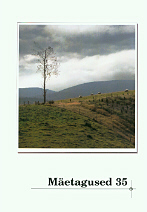Kassi helge kuju eesti rahvapärimuses
The Happy Image of the Cat in Estonian Folklore: How and Why?
Author(s): Kristi SalveSubject(s): Customs / Folklore
Published by: Eesti Kirjandusmuuseum
Keywords: cat; pet; beliefs; source of subsistence; horse; hare; truisms; black magic
Summary/Abstract: The article opens with an overview about the extremely positive image of the cat in contemporary Estonian media, but also about the considerably more ambivalent image familiar from modern beliefs, truisms, narrative sequels, and comparisons. Some truisms and other lore material that have remained active in the tradition until the 21st century are considerably older, but have also been subject to transformation of function and genre – for example, an earlier belief has transformed into a narrative sequel. A brief characterisation of cats in various folklore genres – folktales, legends of origin, folk songs, riddles, etc. – has been provided. The image of cat in these genres, and compared to the image of cat in beliefs, is highly variable. The article is largely based on material found in the files of folk beliefs at the Estonian Folklore Archives. Very generally, the files include material on the beliefs of 19th-century Estonians and the taboos, orders, etc. proceeding from these. Although the Estonian village cat was a domestic animal, primarily of pragmatic function, the bond between people and cats was somewhat closer. Many belief reports concerning the housetraining of cat or the loss of such habits, and also a number of specific predictions on the observance and interpretation of cat’s behaviour, reveal that cats spent a lot of time together with people in the living quarters. Evidently, it was only the modernisation processes that commenced in the late 19th century that started to keep cats away from the living quarters, where they returned as pets only in modern times. Some truisms and myths or beliefs known in the recent past, and partly today, are most likely quite recent, having been introduced by literary sources towards the end of the 19th century. In these sources, a cat is viewed as a demonic and dangerous creature, the (black) cat is interpreted as a witch’s animal or a tool used in witchcraft. Earlier layers of beliefs about cats are concerned with his productive-magic function. A cat was believed to be closely related to horses: holding a cat, feeding it well and taking good care of it was rewarded with luck in horse-breeding, and vice versa: hitting or mistreating a cat resulted in feeble and weak horses. Cat here functions as the substitute of weasel, which was formerly believed to be the spirit of stables and the embodiment of the guardian of horses. According to a more independent belief about the relationship of cats and horses, it was forbidden to take a cat somewhere with horses – a situation which would be rarely encountered, or indeed needed, in real life.
Journal: Mäetagused. Hüperajakiri
- Issue Year: 2007
- Issue No: 35
- Page Range: 47-94
- Page Count: 48
- Language: Estonian

